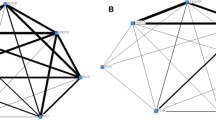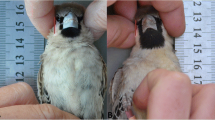Summary
In the subsocial terricolous spiderCoelotes terrestris, the young usually leave the maternal tube and disperse after a 4–6-week gregarious period. In the present experiment they were artificially prevented from dispersing, while being liberally provided with prey. Under such conditions they appeared to maintain a certain level of organization: reproduction, structured silken production, and stabilized mortality. This last characteristic was shown, using specifically designed tests, to be due to a higher tolerance level in group-maintained as compared to freely dispersed, adult spiders. The influence of social situations on tolerance tendencies was further assessed (together with the determining influence of the mother) by prematurely separating spiderlings from their brood. Such phenomena may be considered evidence of preadaptations to permanent social life in this subsocial species.
Similar content being viewed by others
References
Burgess, J. W., 1979. Web signal processing for tolerance and group predation in the social spiderMallos gregalis Simon.Anim. Behav. 27:157–164.
Burgess, J. W. and G. W. Uetz, 1982. Social-spacing strategies in spiders. In:Spider communication: Mechanisms and Ecological Significance (P. N. Witt and J. S. Rovner, Eds.), Princeton University Press, Princeton, pp. 317–351.
Buskirk, R. E., 1981. Sociality in the Arachnida. In:Social Insects (H. R. Hermann, Ed.), N. Y. Academic Press, Vol. II, pp. 281–367.
Gundermann, J. L., 1989. Etudes sur le comportement maternel et son implication dans les phénomènes sub-sociaux chez l'araignéeCoelotes terrestris (Wider).Thèse Doct. Univ. Nancy I.
Gundermann, J. L., A. Horel and B. Krafft, 1988. Maternal food-supply and its regulation inCoelotes terrestris (Araneae, Agelenidae).Behaviour 107:278–296.
Horel, A. and J. L. Gundermann, 1992. Egg sac guarding by the funnel-web spiderCoelotes terrestris: function and development.Behav. Proc. 31:285–294.
Krafft, B., 1969. Various aspects of the biology ofAgelena consociata Denis when bred in the laboratory.Am. Zool. 9:201–210.
Krafft, B., 1971. Contribution à la biologie et à l'éthologie d'Agelena consociata Denis (araignée sociale du Gabon).Biologia Gabonica, C VII, 1:3–56.
Krafft, B., 1975. La tolérance réciproque chez l'araignée socialeAgelena consociata Denis.Proc. 6th Int. Arachn. Congr. Amsterdam 107–112.
Krafft, B., A. Horel and J. M. Julita, 1986. Influence of food-supply on the duration of the gregarious phase of a maternal-social spiderCoelotes terrestris (Araneae, Agelenidae).J. Arachnol. 14:219–226.
Kullmann, E. J., 1968. Soziale Phaenomene bei Spinnen.Ins. Soc. 15:289–298.
Kullmann, E. J., 1972. Evolution of social behavior in spiders (Araneae; Eresidae and Theridiidae).Am. Zool. 12:419–426.
Riechert, S. E., 1978. Energy-based territoriality in populations of the desert spiderAgelenopsis aperta.Symp. Zool. Soc. Lond. 42:211–222.
Roeloffs, R. and S. E. Riechert, 1988. Dispersal and population-genetic structure of the cooperative spider,Agelena consociata, in West African rainforest.Evolution 42:173–183.
Ruttan, L. M., 1990. Experimental manipulations of dispersal in the subsocial spider,Theridion pictum.Behav. Ecol. Sociobiol. 27:169–173.
Ruttan, L. M., 1991. Effects of maternal presence on the growth and survival of subsocial spiderlings (Araneae: Theridiidae).J. Insect. Behav. 4:251–256.
Rypstra, A. L., 1985. Aggregations ofNephila clavipes (L.) (Araneae, Araneidae) in relation to prey availability.J. Arachnol. 13:71–78.
Rypstra, A. L., 1986. High prey abundance and a reduction in cannibalism: the first step to sociality in spiders (Arachnida).J. Arachnol. 14:193–200.
Rypstra, A. L., 1989. Foraging success of solitary and aggregated spiders: insights into flock formation.Anim. Behav. 37:274–281.
Sakagami, S. F. and Y. Maeta, 1980. Artificially induced multifemale nests in the basically solitary beeCeratina japonica. XVI int. Congr. Ent., Kyoto, Abstract: 435.
Sakagami, S. F. and Y. Maeta, 1989. Compatibility and incompability of solitary life with eusociality in two normally solitary beesCeratina japonica andCeratina Okinawa (Hymenoptera, Apoidea), with notes on the incipient phase of eusociality.Jpn. J. Ent. 57:417–439.
Segers, H. and J. P. Maelfait, 1990. Field and laboratory observations on the life cycle ofCoelotes terrestris andC. inermis (Araneae: Agelenidae).C. R. XII Coll. Europ. Arachnol., Paris.
Seibt, U. and W. Wickler, 1988. Bionomics and social structure of “Family Spiders” of the genusStegodyphus with special reference to the African speciesS. dumicola andS. mimosarum (Araneidae, Eresidae).Verh. naturwissen. Ver. Hamburg 30:255–303.
Shear, W. A., 1970. The evolution of social phenomena in spiders.Bull. Brit. Arachnol. Soc. 1:65–77.
Tretzel, E., 1961. Biologie, Oekologie und Brutpflege vonCoelotes terrestris (Wider) (Araneae, Agelenidae). II Brutpflege.Z. Morph. Oekol. Tiere 50:375–542.
Uetz, G. W., T. C. Kane and G. E. Stratton, 1982. Variation in the social grouping tendency of a communal web-building spider.Science J. 217:547–549.
Valerio, C. E. and M. V. Herrero, 1977. Tendencia social en adultes de la AranaLeucauge, sp. (Araneae, Araneidae) en Costa Rica.Brenesia 10/11:69–79.
Vollrath, F., 1982. Colony foundation in a social spider.Z. Tierpsychol. 60:313–324.
Wheeler, W. M., 1928.The social Insects. Their origin and evolution. Kegan Paul Trench Trubner and Co. London.
Wilson, E. O., 1971.The Insect Societies. Harvard University Press, Cambridge, Massachusetts.
Author information
Authors and Affiliations
Rights and permissions
About this article
Cite this article
Gundermann, J.L., Horel, A. & Krafft, B. Experimental manipulations of social tendencies in the subsocial spiderCoelotes terrestris . Ins. Soc 40, 219–229 (1993). https://doi.org/10.1007/BF01240709
Received:
Revised:
Accepted:
Issue Date:
DOI: https://doi.org/10.1007/BF01240709




